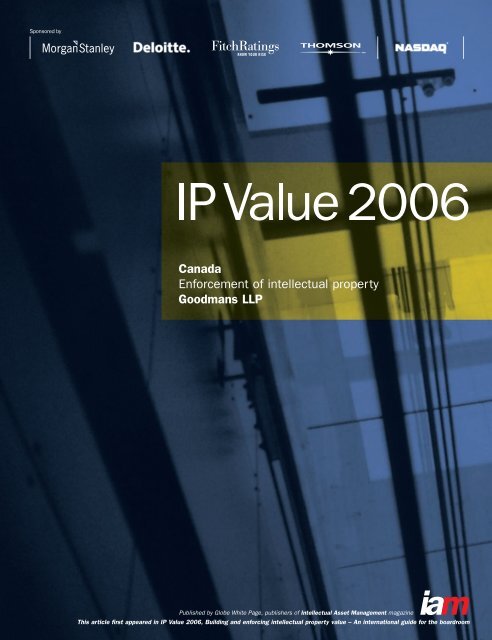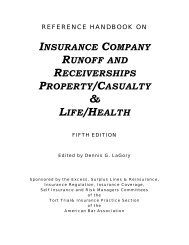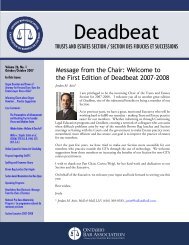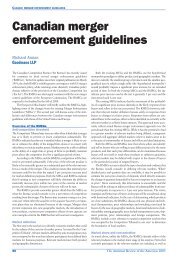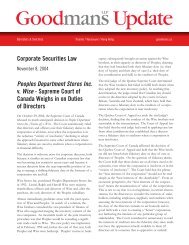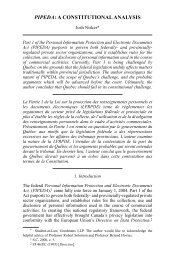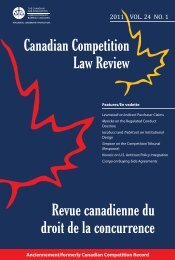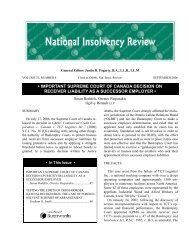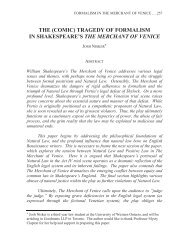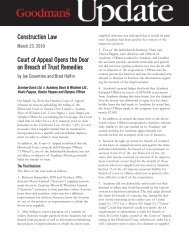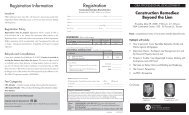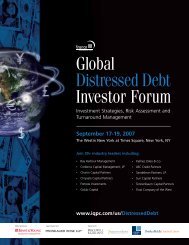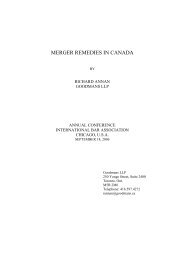Canada Enforcement of intellectual property Goodmans LLP
Canada Enforcement of intellectual property Goodmans LLP
Canada Enforcement of intellectual property Goodmans LLP
Create successful ePaper yourself
Turn your PDF publications into a flip-book with our unique Google optimized e-Paper software.
<strong>Canada</strong><br />
<strong>Enforcement</strong> <strong>of</strong> <strong>intellectual</strong> <strong>property</strong><br />
<strong>Goodmans</strong> <strong>LLP</strong><br />
This article first appeared in IP Value 2006, Building and enforcing <strong>intellectual</strong> <strong>property</strong> value – An international guide for the boardroom
Harry B Radomski, Richard E Naiberg and Miles Hastie<br />
<strong>Goodmans</strong> <strong>LLP</strong><br />
<strong>Canada</strong><br />
<strong>Enforcement</strong> <strong>of</strong> <strong>intellectual</strong> <strong>property</strong><br />
In <strong>Canada</strong>, the time required for an IP case to reach final<br />
determination (including the exhaustion <strong>of</strong> all appeals)<br />
varies widely, from as little as two to as many as 19 years,<br />
with an IP infringement action taking an average <strong>of</strong> three<br />
to five years to reach trial. The appeal <strong>of</strong> the trial result<br />
may require at least a further year to be determined.<br />
The principal factors that determine the length <strong>of</strong> a<br />
dispute are the nature <strong>of</strong> the dispute, the specific<br />
procedure invoked, the intensity with which the plaintiff<br />
prosecutes the matter, the frequency with which interim<br />
decisions are appealed, the degree <strong>of</strong> cooperation shown<br />
by each party, the complexity <strong>of</strong> the action and the<br />
expected trial length. Most Canadian courts have<br />
adopted measures to help bring cases to trial faster.<br />
IP enforcement is typically litigated using one <strong>of</strong> two<br />
procedures: an application or an action. In pharmaceutical<br />
cases, where a patent contains claims to a medicine or to<br />
the use <strong>of</strong> a medicine, the owner <strong>of</strong> the patent may invoke<br />
a summary application procedure, in the form <strong>of</strong> an<br />
notice-<strong>of</strong>-compliance proceeding, to prevent the issuance<br />
<strong>of</strong> a marketing approval to the manufacturer <strong>of</strong> a generic<br />
version <strong>of</strong> the medicine before the expiry <strong>of</strong> the patent.<br />
The application procedure is also available in those very<br />
rare IP cases where no facts are in dispute.<br />
Applications are determined on the basis <strong>of</strong> affidavit<br />
evidence and transcripts <strong>of</strong> out-<strong>of</strong>-court cross-examinations<br />
upon the affidavit evidence, without complete pre-trial oral<br />
and documentary discovery. Applications are subject to<br />
fairly strict timetables and pre-hearing motions are<br />
discouraged. As a result, these proceedings, excluding any<br />
appeal, are <strong>of</strong>ten resolved within two years. However,<br />
pharmaceutical patent notice-<strong>of</strong>-compliance proceedings<br />
do not finally determine the patent rights <strong>of</strong> the parties,<br />
which may still be litigated by ordinary action.<br />
Most IP enforcement cases proceed as actions. These<br />
involve an initial exchange <strong>of</strong> pleadings, extensive<br />
documentary and oral discovery, the exchange <strong>of</strong> expert<br />
reports and a trial where witnesses give their evidence<br />
before a judge (and, on rare occasions, a jury).<br />
In <strong>Canada</strong>, the plaintiff has the carriage <strong>of</strong> the action and<br />
can greatly influence the speed <strong>of</strong> its progression through<br />
trial. The rules <strong>of</strong> procedure contain fairly short deadlines<br />
for the completion <strong>of</strong> pre-trial steps. After ensuring that it<br />
meets its own procedural obligations, a plaintiff can use<br />
these rules to its advantage and force the defendant through<br />
the process, sometimes by seeking court orders compelling<br />
the defendant to do certain things by specific deadlines.<br />
While motions to the court are expensive, they are typically<br />
effective in moving a case along.<br />
In some cases parties attempt to streamline the case<br />
by first trying the issues <strong>of</strong> liability (the validity and<br />
infringement <strong>of</strong> the plaintiff’s IP rights), only later to<br />
have discovery and trial on the issue <strong>of</strong> the nature and<br />
amount <strong>of</strong> the remedy if required. This bifurcation may<br />
save time in some cases, but not in others.<br />
As a case makes its way to trial, there are many<br />
opportunities for disagreement between the parties. Unlike<br />
some other jurisdictions, in Canadian discovery each party<br />
can decide that certain documents or information in its<br />
possession are irrelevant to the issues in the case and refuse<br />
to produce them, generating significant disputes over the<br />
relevance <strong>of</strong> documents and information. These must <strong>of</strong>ten<br />
be resolved by the court at a motion.<br />
These and other matters <strong>of</strong> disagreement can<br />
considerably slow a case as the parties wait for a motion<br />
date, its outcome, an appeal date and its outcome. Further,<br />
in many IP cases, examinations for discovery can be<br />
lengthy and their scheduling may require the cooperation<br />
<strong>of</strong> witnesses and counsel, which is <strong>of</strong>ten <strong>of</strong> crucial<br />
importance to the speed with which a case is determined.<br />
Finally, there is usually considerable delay in securing<br />
a trial date once a case is certified ready for trial.<br />
Depending on the court chosen and the length <strong>of</strong> the<br />
hearing, trial wait times can exceed two years.<br />
Cost <strong>of</strong> taking an action through the courts<br />
The costs <strong>of</strong> an IP case include the filing fees that must<br />
accompany certain court documents, the costs <strong>of</strong><br />
68<br />
Building and enforcing <strong>intellectual</strong> <strong>property</strong> value 2006
<strong>Goodmans</strong> <strong>LLP</strong> <strong>Canada</strong><br />
transcripts, photocopying, binding, travel, expert and<br />
witness fees and, most significantly, legal fees.<br />
In <strong>Canada</strong>, legal fees are typically calculated on a perhour<br />
basis. Depending on experience, expertise and<br />
location, lawyers’ billing rates can range from C$500 to<br />
C$750 per hour for senior counsel and C$180 to C$400<br />
per hour for junior counsel.<br />
In addition, the losing party in a case must expect<br />
to pay at least a portion <strong>of</strong> the winning party’s reasonable<br />
legal costs. Ordinarily, the losing party will be required<br />
to pay 25 per cent to 40 per cent <strong>of</strong> the opposing party’s<br />
actual costs. In rare cases where the court finds a punitive<br />
costs award is appropriate, the award can approach full<br />
indemnity for costs.<br />
Most IP cases tried in <strong>Canada</strong> involve the use <strong>of</strong><br />
expert evidence. As with lawyers, the cost <strong>of</strong> experts may<br />
be considerable and varies from case to case and expert<br />
to expert.<br />
As the costs <strong>of</strong> IP enforcement actions can vary<br />
widely, it is best to contact Canadian counsel for an<br />
estimate at the outset <strong>of</strong> the proceeding.<br />
Are the courts specialised for IP matters?<br />
As noted above, IP actions in <strong>Canada</strong> may be commenced<br />
in either the provincial courts or the Federal Court. In<br />
most instances, the Federal Court is preferred because <strong>of</strong><br />
the nationwide effect <strong>of</strong> its orders (favouring a plaintiff)<br />
and its ability to expunge registrations for copyrights,<br />
trademarks, patents, industrial designs and other IP rights<br />
(favouring a defendant). However, the provincial courts<br />
must be used for trade secret and breach <strong>of</strong> contract cases.<br />
As IP actions form a significant part <strong>of</strong> the caseload <strong>of</strong><br />
the Federal Court, many Federal Court judges have<br />
expertise in the area. The experience <strong>of</strong> judges <strong>of</strong> the<br />
provincial courts with IP cases is more varied.<br />
Pro or anti-IP owners?<br />
<strong>Canada</strong> has ratified major IP treaties in the fields <strong>of</strong><br />
patents and copyright, providing some degree <strong>of</strong><br />
uniformity in basic IP rights with other nations.<br />
Canadian courts, particularly the Federal Court, are<br />
regarded as being friendly to rights holders. IP rights are<br />
given a broad and liberal interpretation to support their<br />
validity and to find infringement.<br />
In addition, there is no doctrine <strong>of</strong> file wrapper<br />
estoppel in <strong>Canada</strong> and, thus, statements made by an<br />
applicant for IP instruments may not be used to interpret<br />
(ie, limit) the scope <strong>of</strong> the applicant’s rights once the<br />
instrument issues. Further, the documentary disclosure<br />
requirements, which are lower than those in other<br />
jurisdictions, yield more favourable results for rights<br />
holders, particularly on issues <strong>of</strong> validity.<br />
Remedies available to rights owners<br />
The remedies that may be available to IP rights holders<br />
for infringement <strong>of</strong> their rights include:<br />
• temporary and permanent injunctions to prevent<br />
further infringement;<br />
• seizure and destruction <strong>of</strong> any infringing articles<br />
in the defendant’s possession;<br />
• damages for losses suffered by the rights<br />
holder including, in the case <strong>of</strong> copyright,<br />
statutory damages;<br />
• as an alternative to compensatory damages, an<br />
accounting <strong>of</strong> the defendant’s pr<strong>of</strong>its earned by<br />
the infringement;<br />
• punitive and exemplary damages; and<br />
• recovery <strong>of</strong> legal and expert expenses.<br />
Key points to be aware <strong>of</strong> when enforcing IP rights<br />
When planning to litigate IP rights in <strong>Canada</strong>, the<br />
potential plaintiff should keep in mind the following:<br />
• Different IP cases are subject to different limitation<br />
periods, which should be discussed with counsel<br />
before proceeding.<br />
• The Canadian courts consider decisions <strong>of</strong> foreign<br />
courts involving IP rights, but do not simply<br />
adopt them.<br />
• Experimental and other non-commercial work with a<br />
patented article and repair <strong>of</strong> the article may not<br />
constitute infringement.<br />
• Canadian patent law provides certain exemptions from<br />
infringement for products acquired prior to the issuance<br />
<strong>of</strong> a patent – counsel should be sought to determine<br />
whether a given activity comes within this exemption.<br />
• Mechanisms exist to bring actions against John or<br />
Jane Doe defendants – upon the commencement <strong>of</strong><br />
such a proceeding, third parties can be compelled to<br />
disclose information about their identities in order to<br />
prosecute the proceeding.<br />
• Foreign plaintiffs and those seeking to impeach a<br />
patent, if requested, must post security for the<br />
defendant’s costs as a condition <strong>of</strong> proceeding in<br />
<strong>Canada</strong>; the amount <strong>of</strong> security depends on the costs<br />
expected to be incurred by the defendant and may<br />
<strong>of</strong>ten be advanced in stages as the action progresses.<br />
• Oral and written information obtained at discovery may<br />
not be used for any purpose collateral to the Canadian<br />
proceeding without leave <strong>of</strong> the court; improper use <strong>of</strong><br />
such information may constitute contempt <strong>of</strong> court.<br />
• Sealing (protective) orders <strong>of</strong> the court seeking to<br />
preserve confidential information <strong>of</strong> the parties are<br />
<strong>of</strong>ten available.<br />
Building and enforcing <strong>intellectual</strong> <strong>property</strong> value 2006 69
<strong>Canada</strong> <strong>Goodmans</strong> <strong>LLP</strong><br />
• There is a specialised IP bar – while general<br />
practitioners may take patent, copyright and<br />
trademark matters, particularly in the provincial<br />
courts, specialised counsel should be considered for<br />
all IP litigation.<br />
Availability <strong>of</strong> damages and an account <strong>of</strong> pr<strong>of</strong>its<br />
An award <strong>of</strong> damages to a successful plaintiff in an<br />
IP action is intended to place the plaintiff in the<br />
same position that it would have been in had the<br />
infringement not occurred. Accordingly, a rights holder<br />
can recover the pr<strong>of</strong>its it proves it lost to infringement or<br />
can recover damages based upon a calculation <strong>of</strong> a<br />
reasonable royalty.<br />
Punitive damages awards in IP infringement actions<br />
are rare. The courts will more frequently punish<br />
egregious conduct on the part <strong>of</strong> an infringer with<br />
recovery <strong>of</strong> legal expenses on a full indemnity basis.<br />
In <strong>Canada</strong>, unlike in some other jurisdictions, the<br />
courts can and <strong>of</strong>ten are willing to permit an IP rights<br />
holder to elect to claim the pr<strong>of</strong>its <strong>of</strong> an infringer as an<br />
alternative to damages. Only the pr<strong>of</strong>its earned that are<br />
causally attributable to the infringement are recoverable.<br />
Availability <strong>of</strong> interlocutory relief<br />
The most common form <strong>of</strong> interlocutory relief is an<br />
injunction to prevent infringement until trial. In order to<br />
obtain an interlocutory injunction, the applicant must<br />
satisfy a three-part test.<br />
First, the applicant must demonstrate that its action is<br />
not frivolous and that it raises a serious issue to be<br />
determined. This is a fairly low threshold.<br />
Second, the applicant must establish that the<br />
injunction is not granted it will suffer ‘irreparable harm’,<br />
meaning harm that cannot be quantified in monetary<br />
terms or cannot be cured by an award <strong>of</strong> damages and a<br />
prohibitory injunction at trial, usually because one party<br />
cannot collect damages from the other. The harm in each<br />
case will be assessed on its particular facts. An injunction<br />
may be granted where a party would otherwise be put<br />
out <strong>of</strong> business or suffer permanent market loss or<br />
irrevocable damage to its business reputation. However,<br />
as IP cases <strong>of</strong>ten involve losses that are primarily<br />
monetary, the difficulty in proving irreparable harm<br />
means that injunctions are infrequently granted.<br />
Finally, if an applicant for an injunction establishes<br />
that it will suffer irreparable harm if the injunction is not<br />
granted, the court will weigh the relative harm that<br />
would be suffered by the parties if an interlocutory<br />
injunction were granted or refused and make a<br />
discretionary determination <strong>of</strong> where the balance <strong>of</strong><br />
convenience lies.<br />
An exception to the difficulties in obtaining<br />
interlocutory injunctions arises in the context <strong>of</strong><br />
pharmaceutical patents, where Canadian legislation<br />
gives patent holders the right to an automatic statutory<br />
injunction without having to satisfy the test normally<br />
applicable for the grant <strong>of</strong> such relief. This enables patent<br />
holders to prevent competitors from entering the market.<br />
Legislation links the regulatory (health and safety)<br />
approval process for pharmaceutical products to<br />
pharmaceutical patent rights and allows patentees to<br />
invoke a 24-month statutory injunction where a generic<br />
competitor compares its product to that <strong>of</strong> the patent<br />
holder for the purposes <strong>of</strong> regulatory approval.<br />
Alternatives to litigation<br />
As IP litigation is lengthy and costly, parties may wish to<br />
consider using alternative dispute resolution techniques<br />
to resolve IP disputes.<br />
Mediation and arbitration involve participation by a<br />
neutral third party (<strong>of</strong>ten a retired judge or judges)<br />
chosen by the parties to reach a resolution outside the<br />
court system. Mediation involves the third party<br />
acting as a facilitator <strong>of</strong> consensual discussions and<br />
negotiations, whereas an arbitrator can ultimately<br />
impose a binding resolution upon the parties (with<br />
or without appeal rights). Some Canadian courts<br />
require parties to attempt mediation before proceeding<br />
to trial.<br />
Mediation and arbitration <strong>of</strong>fer procedural flexibility<br />
and reduced costs, permitting the parties to choose their<br />
mediator/adjudicator, set the evidentiary rules and<br />
schedule the steps in the proceeding. Mediation and<br />
arbitration <strong>of</strong>ten make it easier for the parties to preserve<br />
a business relationship. However, as IP disputes <strong>of</strong>ten<br />
involve claims <strong>of</strong> market exclusivity, compromise is <strong>of</strong>ten<br />
impossible and binding judicial determinations may be<br />
preferred to alternative dispute resolution techniques.<br />
Another means <strong>of</strong> reducing litigation costs is by<br />
reducing the scope <strong>of</strong> the issues to be litigated. The Federal<br />
Court can conduct a mini-trial <strong>of</strong> the case, or a portion <strong>of</strong><br />
the case, and render a non-binding opinion as to the<br />
probable outcome <strong>of</strong> the proceeding. In addition, the court<br />
has the power to sever issues and try them separately.<br />
Recent developments in IP litigation<br />
In the last year some <strong>of</strong> the most significant<br />
developments in <strong>intellectual</strong> <strong>property</strong> in <strong>Canada</strong> have<br />
involved legislative reform.<br />
Parliament has enacted two bills modifying the<br />
Patent Act to permit drug manufacturers to obtain<br />
compulsory licences for the export <strong>of</strong> medicines to<br />
African countries, and to permit patentees to correct<br />
70<br />
Building and enforcing <strong>intellectual</strong> <strong>property</strong> value 2006
<strong>Goodmans</strong> <strong>LLP</strong> <strong>Canada</strong><br />
past payments to the Patent Office whose inadequacy<br />
previously invalidated patents.<br />
Parliament is also considering a bill that would<br />
significantly amend the Canadian Copyright Act to ratify<br />
World Intellectual Property Organisation treaties by<br />
extending rights <strong>of</strong> performers and creators <strong>of</strong> sound<br />
recordings, introducing rights associated with digital rights<br />
management and technological protection measures, and<br />
creating notice and retention provisions to require internet<br />
hosts, upon request, to inform their users <strong>of</strong> and retain<br />
information regarding allegations <strong>of</strong> infringement.<br />
On the judicial front, in one recent case the Supreme<br />
Court <strong>of</strong> <strong>Canada</strong> indicated that passive internet service<br />
providers were not liable for copyright infringement<br />
perpetrated by their users. The Supreme Court also held<br />
that digital copyright infringement can take place<br />
whenever the infringement has a “real and substantial<br />
connection” to <strong>Canada</strong>, whether or not the supplier, host<br />
or receiver <strong>of</strong> the copyrighted material is located in<br />
<strong>Canada</strong>. In a second case, the Supreme Court held that<br />
copyright required its material to be the subject <strong>of</strong> “an<br />
exercise <strong>of</strong> skill and judgment”, rejecting the lower ‘sweat<br />
<strong>of</strong> the brow’ and higher ‘creativity standard <strong>of</strong> originality’<br />
standards. The Supreme Court also established a multifaceted<br />
test to determine whether the fair dealing<br />
exemption from copyright infringement applies.<br />
In a recent Federal Court <strong>of</strong> Appeal decision, the court<br />
held that internet service providers could be compelled<br />
by copyright holders to provide information about John<br />
and Jane Doe defendant users if they have a genuine<br />
claim and are unable to access the information from<br />
another source. The Federal Court <strong>of</strong> Appeal also<br />
disapproved <strong>of</strong> the lower court’s determination that<br />
copyright infringement exemptions would necessarily<br />
apply in the context <strong>of</strong> downloading or sharing digital<br />
music files through peer-to-peer networks.<br />
In patent law, the Supreme Court <strong>of</strong> <strong>Canada</strong><br />
has recently held that innocent intent is not generally<br />
a defence to patent infringement. Obtaining an<br />
advantage from the patented article, no matter whether<br />
it is precisely the same one intended by the<br />
patentee, constitutes patent infringement, and<br />
possession <strong>of</strong> a patented article may give rise to a<br />
presumption <strong>of</strong> infringement.<br />
In pharmaceutical patent law, the Supreme Court<br />
recently held that the prohibition order available to<br />
patentees to prevent generic drug manufacturers<br />
from obtaining marketing approval can be obtained only<br />
to prevent abuse <strong>of</strong> the patent infringement exemptions<br />
for regulatory and experimental use <strong>of</strong> the patented<br />
subject matter.<br />
Harry heads the firm’s IP group. He obtained his BComm (1972) and LLB<br />
(1975) from the University <strong>of</strong> Toronto and his LLM (1976) from the University<br />
<strong>of</strong> California at Berkeley. He has been a partner since 1987 and<br />
is a member <strong>of</strong> the firm’s executive committee. In 1999 Harry was named<br />
Canadian IP patent litigator <strong>of</strong> the year by Managing Intellectual Property.<br />
He has written and spoken extensively on various IP issues, and lectures<br />
in IP law.<br />
Harry B Radomski<br />
Partner, Toronto<br />
Tel +1 416 597 4142<br />
Email hradomski@goodmans.ca<br />
<strong>Goodmans</strong> <strong>LLP</strong><br />
<strong>Canada</strong><br />
Richard is a partner in the litigation section. He holds a BEng<br />
from the University <strong>of</strong> Western Ontario (1987) and an LLB from the<br />
University <strong>of</strong> Toronto (1991). He joined <strong>Goodmans</strong> in 1993 and practises IP<br />
and general commercial litigation. Richard is the secretary <strong>of</strong> the IP section<br />
<strong>of</strong> the Canadian Bar Association, and sits on several committees <strong>of</strong> the IP<br />
Institute <strong>of</strong> <strong>Canada</strong>. He lectures at the Rotman School <strong>of</strong> Business on IP<br />
rights and remedies.<br />
Richard E Naiberg<br />
Partner, Toronto<br />
Tel +1 416 597 4247<br />
Email rnaiberg@goodmans.ca<br />
<strong>Goodmans</strong> <strong>LLP</strong><br />
<strong>Canada</strong><br />
Miles is an associate in the litigation section. He received his BA (Hons) from<br />
Queen’s University (1998) and his LLB from the University<br />
<strong>of</strong> Western Ontario (2003). He articled at <strong>Goodmans</strong>, joining the firm in<br />
2004. Miles practises IP and general commercial litigation. He is a<br />
member <strong>of</strong> the IP section <strong>of</strong> the Canadian Bar Association and the<br />
Advocates Society. He is involved in trial and appellate advocacy in the<br />
Ontario and federal courts.<br />
Miles Hastie<br />
Associate, Toronto<br />
Tel +1 416 849 6008<br />
Email mhastie@goodmans.ca<br />
<strong>Goodmans</strong> <strong>LLP</strong><br />
<strong>Canada</strong><br />
Building and enforcing <strong>intellectual</strong> <strong>property</strong> value 2006 71
<strong>Goodmans</strong> <strong>LLP</strong><br />
250 Yonge Street, Suite 2400,<br />
Toronto, Ontario, M5B 2M6, <strong>Canada</strong><br />
Tel: +1 416 979 2211<br />
Fax: +1 416 979 1234<br />
www.goodmans.ca<br />
info@goodmans.ca


